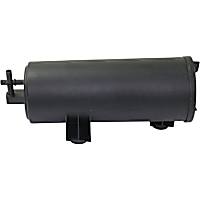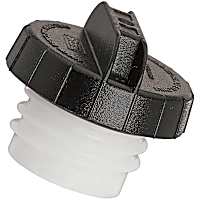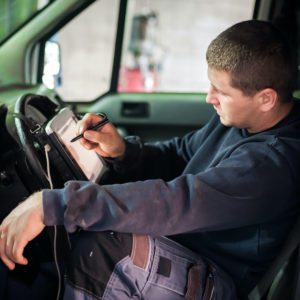If you’ve ever left the gas cap loose on a modern car, there’s a good chance you’ve had an encounter with the evaporative emission control (EVAP) system.
The EVAP system traps smog-forming fuel vapors and prevents them from entering the atmosphere. When there’s a problem—such as a leaking gas cap—somewhere in the system, your car’s primary computer (often referred to as the powertrain control module) will turn on the check engine light. At the same time, the module stores an EVAP-related diagnostic trouble code (DTC) in its memory.
If EVAP system problems didn’t trigger the check engine light, you might not realize the system was there. An EVAP malfunction rarely affects vehicle performance (unless the purge valve is leaking) or driver comfort in any way.
But that doesn’t mean you should ignore a problem with the EVAP system; on the contrary, an EVAP failure is almost guaranteed to prevent your car from passing a state emissions test. What’s more, a problem in the system increases the harmful emissions coming from your vehicle.
It’s a good idea to become familiar with the EVAP system and how it works. That way, you’ll have a basic understanding of the system should any problems arise.

What is an EVAP System?
As was mentioned, the EVAP system prevents fuel vapors from entering the atmosphere. The system does this by trapping the vapors in a vapor canister, then “purging” the vapors into the engine when conditions are correct.
Most vehicles built after 1996 (and all of those built after 1999) have what’s called an “enhanced” EVAP system. Enhanced systems can perform self-tests to check for leaks in addition to proper system operation.

Enhanced EVAP systems lead to fewer vehicle emissions being released into the atmosphere—and that’s a good thing. But the improved self-diagnostic abilities these systems provide also make it easier for a fault to trigger the check engine light.
It’s important to point out that there are a LOT of different enhanced EVAP systems in use today. Furthermore, many vehicle manufacturers have used multiple EVAP system designs over the years.
For example, let’s say you’ve got a Chrysler vehicle. Depending on the year and model, it may have either an older-style Leak Detection Pump (LDP) system, a Natural Vacuum Leak Detection (NVLD) system, or an Evaporative System Integrity Monitor (ESIM).
We won’t get into how all of the different types of EVAP systems work. There’s too much information to cover in one article. Instead, we’ll focus on the most common EVAP system design, which primarily uses a fuel tank pressure sensor for system monitoring.
Note: For information on the specific EVAP system in your vehicle, it’s a good idea to consult a repair manual or repair database.
Parts of an EVAP System
Even a relatively simple EVAP system has many parts—and many ways it can fail. The primary components found in a typical EVAP system include the following:
Vapor Canister
This component, which is also known as a charcoal canister, stores fuel vapors from the gas tank.

Purge Valve
Also known as a canister purge solenoid, this PCM-controlled valve opens to allow fuel vapors to be drawn from the vapor canister into the engine.
Canister Vent Valve
Another PCM-controlled valve, this component closes off the vapor canister to seal the system during self-diagnostics.
Gas Cap
The gas cap has a pressure/vacuum relief valve that opens in the case of a system malfunction.
Fuel Tank Pressure Sensor
The fuel tank pressure sensor or EVAP pressure sensor measures the pressure (and therefore, the vacuum) in the fuel tank.
EVAP System Lines and Hoses
These components connect the various parts of the EVAP system.
How Does an EVAP System Work?
It can be difficult to wrap your head around how a typical EVAP system works. But the good news is that the system’s functions can be broken down into three primary operations: storing fuel vapors, purging fuel vapors, and self-monitoring.

Storing Fuel Vapors
The vapor canister is the focal point of the EVAP system. When the engine is off, fuel vapors from the gas tank are stored in the canister. The canister contains activated charcoal, which traps the vapors until the engine is running, and conditions are correct for a vapor purge.
Normally, the vapor canister is open to the atmosphere to allow fresh air to enter. The canister is only closed when the EVAP monitor is run (more on that later).
Purging Fuel Vapors
On modern vehicles, the PCM determines when to initiate a canister purge. When the module deems conditions to be correct, it commands a solenoid to open the purge valve.
Opening the purge valve creates a vacuum that pulls fresh air through the vapor canister. The fresh air picks up the fuel vapors and delivers them to the engine to be burned during the normal combustion process.
Monitoring for Leaks and Proper System Operation
As was mentioned, all vehicles built after 1999 have enhanced EVAP systems that can perform self-tests for both leaks and proper system operation. This test sequence is referred to as the EVAP monitor.
The monitoring strategy will vary, depending on the type of vehicle.
Here is an example of a large leak test, which is one portion of the EVAP monitoring strategy, from a 2010 Chevy Silverado:
- When the conditions are correct, the control module closes the vent valve and opens the purge valve, creating a vacuum in the system.
- The control module then monitors the fuel tank pressure (FTP) sensor to verify the system can reach a specified amount of vacuum.
- If the vacuum is lower than specified, the module assumes there is a large leak somewhere in the system and stores a DTC in its memory.
What is an EVAP System Leak?
An EVAP system leak is just that—a leak somewhere in the EVAP system. If the size of the leak exceeds a certain value, the PCM will notice it while running the EVAP monitor. When this happens, the module turns on the check engine light and stores a DTC in its memory.
A professional technician (or skilled DIYer) can retrieve these codes with a scan tool or code reader.
In some cases, an EVAP system leak may also trigger the check gas cap warning (on vehicles so equipped).
The EVAP monitor tests the system for both small and large leaks. Examples of DTCs that correspond to leaks include:
- P0442 Evaporative Emission System Leak Detected (small leak)
- P0455 Evaporative Emission System Leak Detected (gross leak/no flow)
- P0456 Evaporative Emission System Leak Detected (very small leak)
A loose gas cap is often the cause of an EVAP system leak code. If your car has a leak code stored, try tightening the gas cap. If that doesn’t do the trick, you may want to try swapping out the gas cap, since replacements are relatively inexpensive.
Pinpointing an EVAP leak that’s not the gas cap can be difficult. Usually, the process requires the use of a professional smoke machine, which forces smoke into the EVAP system so that (hopefully) the leak will become visible when smoke starts billowing out.
Is It Safe to Drive with an Evap Leak?
The answer is, yes, it’s usually safe to continue driving. But because the leak increases the amount of pollution the vehicle emits, you should fix the problem as soon as possible.
EVAP systems can also suffer from problems other than leaks. There’s a wide range of DTCs devoted to everything from a blocked vent valve to inadequate purge flow.
Where To Get New EVAP System Parts
As discussed earlier, there are many parts to your vehicle’s EVAP system. The vapor canister and purge valve are just the start. The gas cap and the various lines and hoses are just as important to a smoothly running system. Unfortunately, if any of these components spring a leak, your vehicle can begin to negatively impact the environment and your health. Thankfully, finding replacement parts for the different components of your EVAP system is easy with CarParts.com
Whether it’s a new vapour canister or a set of new lines you’re after, CarParts.com has you covered. You can place your order for a new part with just a few easy clicks. All you need to do is find the EVAP components you need and check that they fit your vehicle using our vehicle selector. Checkout is quick and easy, and shipping can take as fast as two business days.
Order a new vapor canister or other EVAP system part at CarParts.com today.
Products Mentioned in this Guide
Any information provided on this Website is for informational purposes only and is not intended to replace consultation with a professional mechanic. The accuracy and timeliness of the information may change from the time of publication.


 Vapor Canister
Vapor Canister
 Purge Valve
Purge Valve
 Gas Cap
Gas Cap
 Fuel Tank Pressure Sensor
Fuel Tank Pressure Sensor




























453 code what’s that